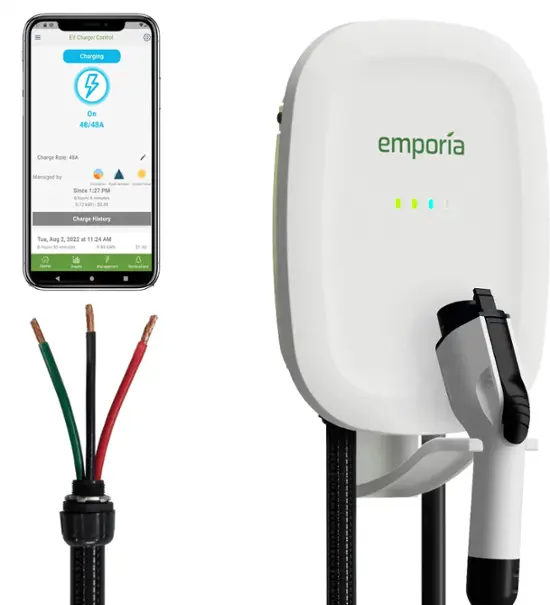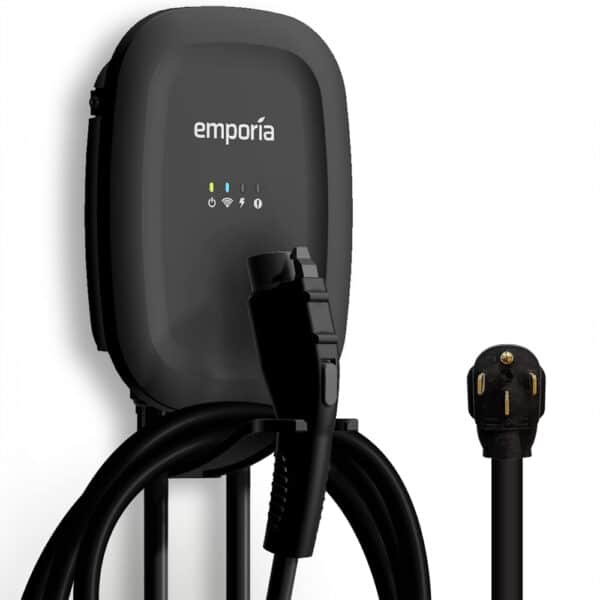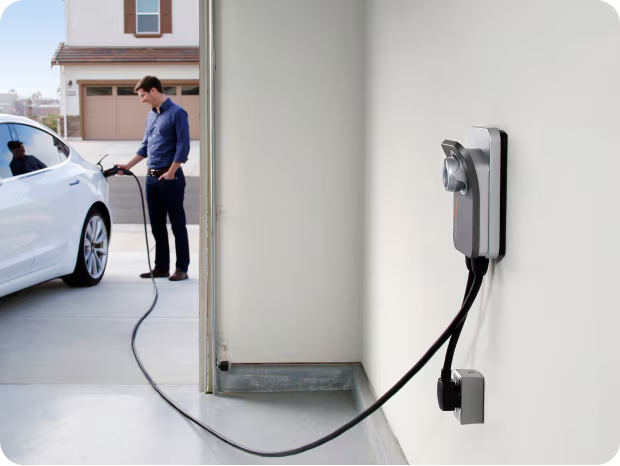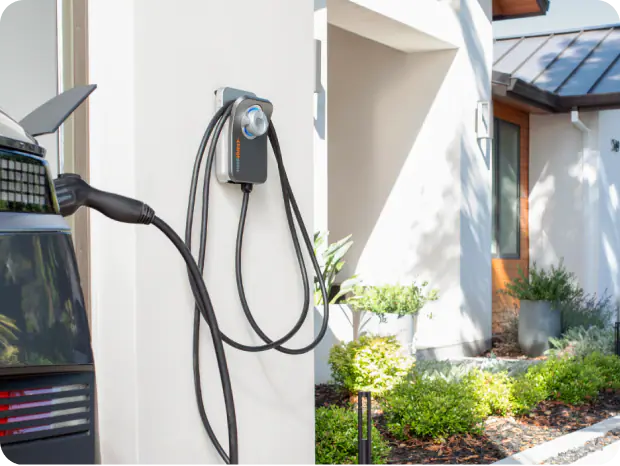

In this in-depth review, we’ll delve into the Emporia EV Charger, examining its setup, charging performance, user interface, and overall functionality. We’ll cover both plug-in and hardwired installations, detailing the electrical requirements and whether professional assistance is necessary.
Then we’ll evaluate the charger’s capabilities, including its adjustable amperage range (up to 48 amps) and compatibility with various electric vehicles. We’ll also discuss its smart features, such as Wi-Fi connectivity, mobile app control, energy monitoring, and customizable charging schedules.
Finally, we’ll assess the charger’s durability, safety features, and compatibility with both J1772 and Tesla’s NACS connectors.
With a robust power output of up to 48 amps, the Emporia EV Charger delivers excellent charging speed, making it suitable for a variety of electric vehicles. Its adjustable amperage settings allow users to customize the charging experience based on their needs and home electrical capacity.
The charger offers impressive smart capabilities, including Wi-Fi connectivity and a user-friendly app for real-time monitoring, scheduling, and energy tracking. The app interface is intuitive and provides valuable insights into energy consumption, although some users may desire more advanced analytics.
The Emporia EV Charger features a robust design with weatherproofing, making it suitable for both indoor and outdoor use. Its construction instills confidence in long-term reliability, although the weight of the unit might necessitate secure mounting for safety.
While the charger is competitively priced given its features and performance, some users might find that additional costs for installation or required electrical upgrades can add to the overall expense. However, the long-term benefits and flexibility offered by the charger make it a solid investment for EV owners.
Emporia is a company that focuses on developing affordable, smart energy management products for homes and businesses. Founded in 2018, Emporia’s mission is to help consumers monitor and manage their energy consumption, aiming to make energy use more efficient, reduce waste, and promote sustainability.
They are best known for their smart home energy monitors and EV chargers, which integrate with solar power systems, battery storage, and other energy solutions. Their products are designed to provide real-time insights into energy usage, allowing users to track and optimize their consumption through connected apps and devices. Emporia emphasizes cost-effectiveness, making advanced energy technologies more accessible to the average homeowner.
The Emporia EV Charger is designed with flexibility and convenience in mind, making it a great option for both current and future EV owners. One feature worth highlighting is the charger’s robust cable, which remains easy to handle and store, even in cold weather conditions.
Wi-Fi Connectivity: While some users occasionally experience connectivity drops, we found that Emporia’s EV charger maintained a strong, stable connection during our testing, ensuring seamless access to energy monitoring and scheduling through the mobile app.
Installation Flexibility: The charger comes in both plug-in and hardwired options. We tested the plug-in version, which uses a standard NEMA 14-50 plug, making it simple to integrate into most home electrical setups without needing extensive modifications.
Easy Installation: The Emporia charger arrives fully assembled, meaning there’s no need to attach the cable separately. This makes installation straightforward for most users, though professional help is always a good option for those unfamiliar with electrical work.
Connector Options: While the charger comes equipped with the widely compatible J1772 connector, Emporia offers flexibility for Tesla owners as well. Using a simple adapter, the charger works seamlessly with Tesla’s NACS system, giving it future-proof appeal as more automakers adopt this standard in the coming years.
High Charging Speed:
Delivers up to 11.5 kW of power with a 48-amp circuit, enabling efficient Level 2 charging for most EVs.
Flexible Installation Options:
Available in both plug-in and hardwired configurations. The plug-in version works with a standard NEMA 14-50 outlet, while hardwiring supports higher amperage if needed.
Amperage Flexibility:
Adjustable from 15 to 48 amps, providing flexibility based on your home’s electrical capacity and your vehicle’s charging requirements.
Solar Integration:
Compatible with solar panel systems, allowing you to charge your EV using renewable energy and monitor solar generation via the app.
Wi-Fi Connectivity & Smart Features:
Connects to Wi-Fi for remote access through the Emporia app, allowing you to:
Durability and Weatherproofing:
Built with durable materials and rated NEMA 4, making it suitable for both indoor and outdoor use, including protection against rain and dust.
Long Cable Length:
Comes with a 24-foot charging cable, providing flexibility to charge from different parking spots.
Safety Features:
Equipped with advanced safety protections, including over-current, over-voltage, and ground fault protection, as well as temperature monitoring.
Future-Proof Compatibility:
Works with the J1772 connector and is compatible with Tesla vehicles via an adapter, ensuring flexibility as standards evolve.
Energy Monitoring:
The app provides detailed insights into energy consumption and charging costs, helping you optimize your charging habits to reduce expenses.
No Native NACS Connector:
Only comes with a J1772 connector, so Tesla owners will need to use an adapter, which may be inconvenient for some users.
Limited Cable Flexibility in Cold Weather:
While durable, the charging cable can become stiff in freezing temperatures, making it slightly harder to handle.
Wi-Fi Connectivity Issues:
Some users report occasional drops in Wi-Fi connectivity, which can interrupt remote monitoring and control.
Professional Installation May Be Required:
Though the plug-in version is easy to install, those opting for the hardwired version or higher amperage settings may need to hire an electrician.
No Built-In Display:
Lacks a built-in screen for real-time monitoring on the charger itself, requiring users to rely on the mobile app for details.
No Load Management Feature:
Does not include advanced load-balancing capabilities, which could limit its use in homes with multiple EVs or high electrical demand.
Bulkier Design:
Slightly larger and heavier compared to some other chargers in the same category, which may affect mounting in tight spaces.
Discover the value of your cars options and specification!
The build quality stands out. Crafted from high-strength plastic and robust materials, this charger is built to last. Its durable construction helps it withstand the rigors of daily use, ensuring it remains effective over time without showing significant wear.
Another highlight is its weather resistance. With a NEMA 4 rating, the Emporia EV Charger is designed to handle a variety of environmental conditions. Whether installed indoors or outdoors, it can effectively protect against rain, dust, and temperature fluctuations, making it a reliable choice for diverse climates.
When it comes to reliability, the charger does not disappoint. It has undergone rigorous testing to meet safety and performance standards, instilling confidence in its ability to deliver efficient and safe charging for electric vehicles.
Choosing a plug-in connection for your Emporia EV Charger offers a convenient and flexible solution for charging your electric vehicle. This method allows for easy installation, as it simply requires a compatible NEMA 14-50 outlet, making it ideal for those who want a hassle-free setup without extensive electrical work.
The plug-in option is particularly beneficial for renters or individuals who may need to relocate their charger in the future. Additionally, the ability to easily unplug and move the charger can be a great advantage if you have multiple parking locations or if you want to take your charger with you while traveling.

On the other hand, opting for a hardwired connection provides a more permanent solution that may be better suited for dedicated charging setups. This method allows you to connect the charger directly to your electrical system, enabling higher amperage options for faster charging speeds.
Hardwiring can also eliminate potential issues with plug connections, such as wear and tear over time. If you have a specific parking location for your vehicle and don’t plan on moving the charger, the hardwired option can be a more efficient and reliable choice. However, it’s important to note that this installation typically requires the expertise of a licensed electrician to ensure safety and compliance with local electrical codes.

When it comes to Wi-Fi connectivity, the Emporia EV Charger offers a significant advantage for users seeking convenience and control over their charging experience.
With its ability to connect to your home Wi-Fi network, you can remotely monitor and manage your charging sessions from anywhere using the Emporia app.
This connectivity allows for real-time tracking of charging status and energy usage, helping you optimize charging times and potentially reduce electricity costs. For tech-savvy users, the ability to access charging data and settings through a smartphone provides a modern and efficient way to manage EV charging.
In addition to Wi-Fi connectivity, the Emporia EV Charger boasts an array of smart features designed to enhance user experience and promote energy efficiency.
With the app, users can schedule charging sessions to take advantage of off-peak electricity rates, receive notifications when charging is complete, and track energy consumption over time. These smart functionalities make it easier to integrate the charger into your daily routine, offering personalized options that cater to your specific charging needs.
Overall, the combination of Wi-Fi connectivity and smart features provides a comprehensive and user-friendly charging solution that maximizes convenience and efficiency.

Ensure Safety First: Before starting, switch off the power to the circuit at the breaker box to avoid electrical hazards.
Mounting Area: Find a suitable location for the charger, accessible to your electric vehicle and in proximity to your electrical panel.
Use the Mounting Bracket: Secure the charger to the wall using the provided bracket and screws.
Mark Drill Holes: Determine the placement and drill the holes for the bracket.
Securely Install the Bracket: Make sure the charger is firmly attached to the wall.
Run Electrical Wire: Extend the electrical wire from the circuit breaker to the charger location.
Use Conduit: Protect the wiring with conduit as needed, particularly if it runs outdoors or through walls.
Open the Charging Unit: Access the internal terminal connections of the charger.
Attach Wires to Terminals: Connect the electrical wires to the appropriate terminals (typically labeled L1, L2, and ground).
Ensure Secure Connections: Double-check that all connections are tight and properly secured.
New Circuit Breaker: Install a new circuit breaker in your electrical panel (if needed) and connect the incoming wires to the breaker.
Follow Local Codes: Adhere to all local electrical codes and guidelines during installation.
Restore Power: Once all connections are complete, turn the power back on at the circuit breaker.
Use the Emporia App: Connect the charger to your home Wi-Fi network through the app and configure any preferred settings.
Plug in Your Vehicle: Connect your electric vehicle to the charger to verify functionality.
Monitor for Errors: Check the app for any error messages or notifications to ensure everything is functioning correctly.
Universal Charging Standard:
Tesla Compatibility:
The Emporia EV Charger is designed to be compatible with a wide range of electric vehicles (EVs), making it a versatile option for EV owners. Here’s an overview of its vehicle compatibility:

Article By: Dale Ogden
Dale is a recognized expert in the automotive industry, known for his expertise in automotive asset management and consulting.
As the founder of Check Your Spec and former Forecast Manager at CAP HPI (equivalent to Kelley Blue Book in the USA) he made significant contributions to the development of forecasting strategies and depreciation models for internal combustion engines, hybrid, and electric commercial vehicles in the UK.
With over two decades of experience, Dale pioneered EV forecasting models that are now used by leading manufacturers.
His work has also produced residual values for over 10,000 new vehicles.
Yes, you can use an Emporia EV Charger with a Tesla. The compatibility comes from the fact that the Emporia charger supports both the J1772 connector and the NACS (North American Charging Standard) connector.
J1772 Connector:
NACS Connector:
An Emporia EV Charger does not strictly need Wi-Fi to function; however, having a Wi-Fi connection significantly enhances its capabilities. Here’s a detailed look at why Wi-Fi can be beneficial and how the charger operates without it:
Remote Access:
Smart Features:
Energy Tracking:
Firmware Updates:
Notifications:
The Charger has a maximum charging power output of 11.5 kW when connected to a 50-amp circuit. This allows for efficient Level 2 charging, which can significantly reduce charging times for electric vehicles. Here’s a breakdown of how the charging rate translates into charging times:
Up to 11.5 kW Output:
Adjustable Amperage:
Charging times will vary based on the battery size of the electric vehicle and the current charge level. Here are some rough estimates based on the maximum output:

Unlock accurate valuations for your car’s features in seconds – find out what your options are worth today and in the future.